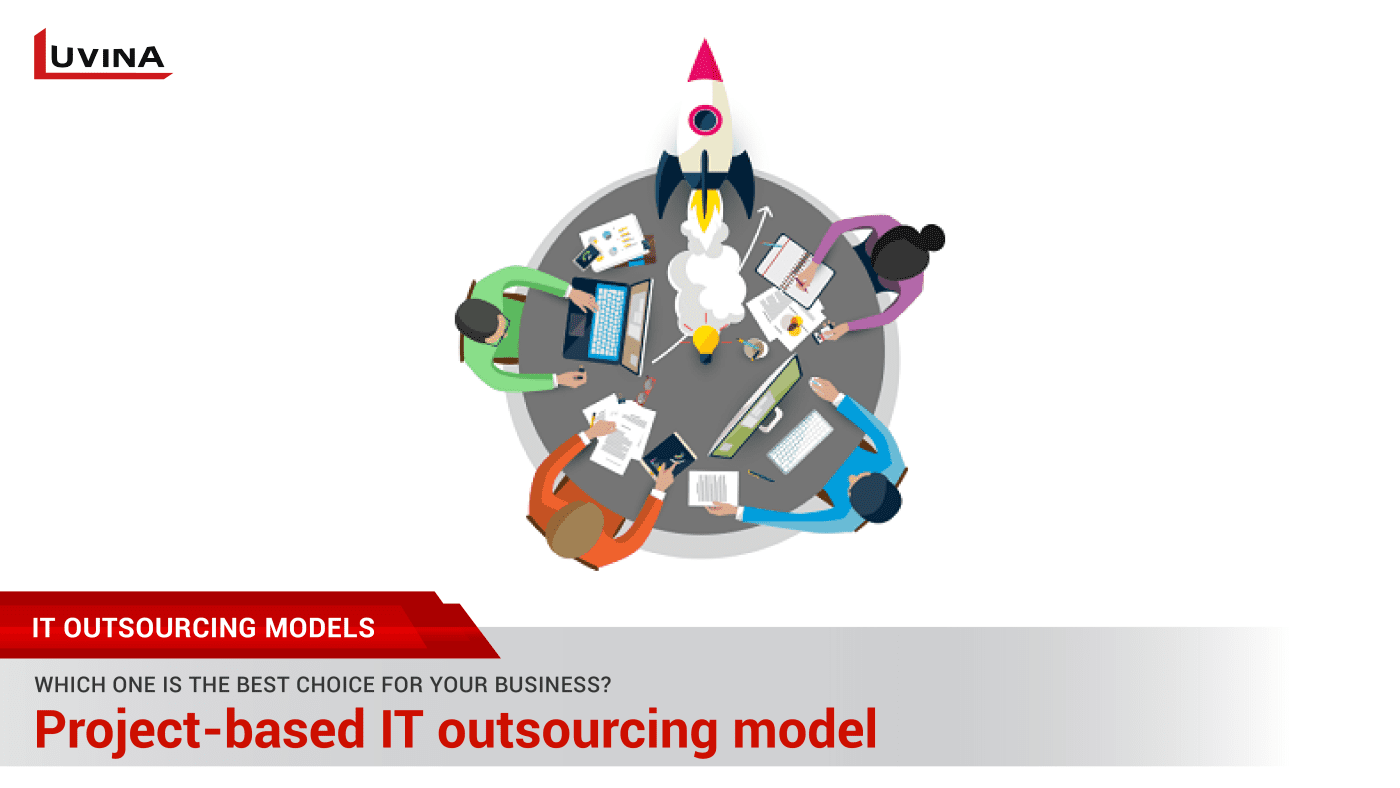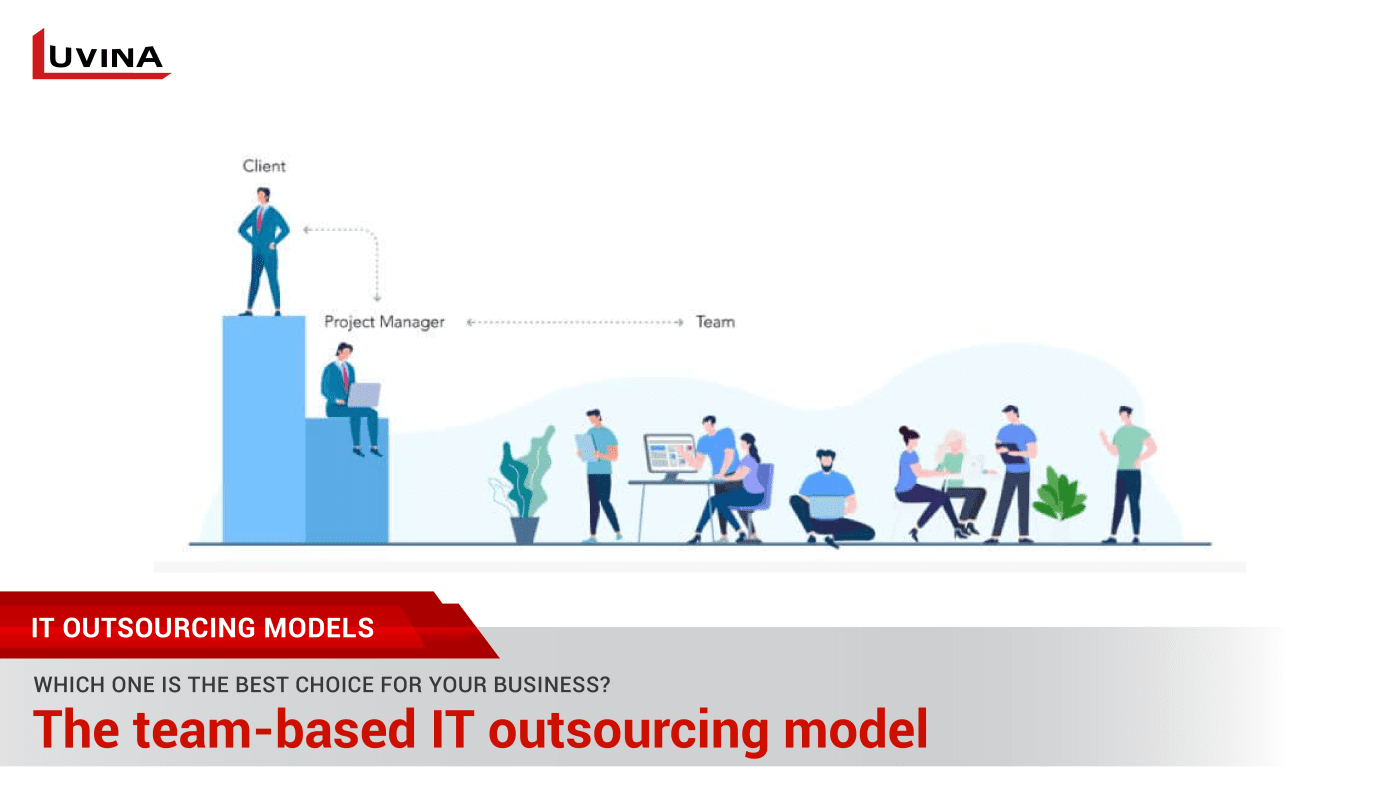In the modern technology world, using IT outsourcing services has become a popular trend in managing and developing businesses. However, before deciding to choose an IT outsourcing model, businesses need to consider and choose carefully based on the appropriate factors. In this article, Luvina will compare two different IT outsourcing models and help businesses choose the most suitable model for their needs.
What Types of IT Outsourcing Models?
You can see and experience different types of IT outsourcing models in operating and managing software projects. However, in this article, Luvina focuses on comparing the two most basic IT outsourcing models: project-based and team-based.

IT outsourcing based on projects (project-based) and IT outsourcing based on teams (team-based) have their own advantages and disadvantages. The project-based model is suitable for specific projects and provides flexibility, while the team-based model is suitable for building and maintaining a long-term IT team. By understanding these models, businesses will have a basis to make smart decisions and optimize their choice of using IT outsourcing models in their businesses.
IT Outsourcing Model Based on Projects (Project-Based)
The project-based IT outsourcing model is a method of hiring a service provider to perform a specific project of a business from start to finish. You can imagine how this IT outsourcing model works as follows: Customers hire an IT service provider (third party) to perform a specific project. This third party will take responsibility from the analysis and design stage, and project implementation, to testing and post-project support. The requirements and scope of the project are clearly defined by the business from the beginning, helping to fully control the process and progress of the project.

Some advantages of the project-based IT outsourcing model can be mentioned as Cost savings because there is no need to invest in building and maintaining an internal IT team. With fast deployment with clear requirements and scope from the beginning, the service provider can start working immediately. Easy project control by setting clear requirements and scope for the third party, as well as monitoring the progress and results of the project from start to finish. Access to specialized skills and expertise of the IT service provider.
However, businesses also need to pay attention to some disadvantages when choosing to apply the project-based IT outsourcing model, such as Limited flexibility due to requirements and scope that have been defined from the beginning, changes can be difficult, and incur additional costs. Dependence on the IT service provider, If the service provider does not meet the standards or encounters problems, the project may be affected in terms of progress and quality. Communication barriers affecting quality due to differences in culture, language, or geography, communication may be barriers when applying the project-based IT outsourcing model. Risk of scope or requirement changes if not well managed, these changes can affect the process, consume time and resources, or even cause unnecessary waste. Some projects that are suitable for applying the project-based IT outsourcing model are:
- – Projects with clear requirements and scope from the beginning.
- – Projects with short duration or one-time projects.
- – Projects that do not require much interaction or communication between parties.
- – Projects that require specialized skills or expertise that are not available internally.
IT Outsourcing Model Based on Teams (Team-Based)
The team-based IT outsourcing model is a method of hiring a service provider to provide a team of IT professionals who work exclusively on a business’s projects. You can imagine how this IT outsourcing model works as follows: Customers hire an IT service provider (third party) to provide a team of IT professionals who work exclusively for their projects. This team can work remotely or onsite depending on the agreement between the parties. The customer has full control over the team’s activities, tasks, performance, and quality.

Some advantages of the team-based IT outsourcing model can be mentioned as Cost savings because there is no need to invest in recruiting, training, or retaining an internal IT team. Flexibility because customers can adjust or scale up or down their team size according to their needs. Full control over the team’s activities, tasks, performance, and quality by customers. Continuity and stability because customers can build long-term relationships with their team members and ensure knowledge transfer and retention. Access to a large pool of talent and expertise from the service provider.
However, businesses also need to pay attention to some disadvantages when choosing to apply the team-based IT outsourcing model, such as High management effort because customers need to manage their team’s activities, tasks, performance, and quality, as well as communicate and coordinate with them regularly. Cultural and geographical differences may affect the team’s collaboration and productivity. Risk of losing control over the team if customers do not have clear expectations or feedback mechanisms for their team members. Risk of losing team members due to turnover or dissatisfaction of the service provider or the team members themselves. Some projects that are suitable for applying the team-based IT outsourcing model are:
- – Projects with unclear or changing requirements and scope.
- – Projects with long duration or ongoing projects.
- – Projects that require a lot of interaction or communication between parties.
- – Projects that require a consistent and dedicated team of IT professionals.

>> See more: Basic Types of IT Outsourcing
Compare the Two IT Outsourcing Models
When placed on the scale to compare the two IT outsourcing models, businesses will get the most comprehensive view to make a decision on which model to choose that suits their characteristics, requirements, and costs.
1. Comparison of characteristics
Luvina has summarized the similarities and differences between the two IT outsourcing models project-based and team-based in the following table:
| Operation | According to a specific project process from start to finish | Integrate into the internal human resources team of the business using outsourced services |
| Flexibility | Limited, difficult-to-change scope and requirements | High flexibility, can customize requirements, expand or narrow scope |
| Cost | Cost savings as there is no need to maintain a team | Higher cost when hiring a team of IT experts |
| Progress | Fast deployment, with a defined time | Integration and learning time longer |
| Management | Fully control the project | Coordinate implementation and manage teams from both sides |
| Skills | Can access specialized skills and expertise from the IT service provider | Can access diverse skills and expertise from the IT service provider |
| Partner relationship | Short-term cooperation | Can have long-term relationships, and long-term cooperation, create trust and stability |
| Risk | May face risks in language communication and quality control | May face risks of losing control of the team and differences in corporate culture |
2. Evaluate the strengths and weaknesses of the two IT outsourcing models
The IT outsourcing model based on project (project-based) and based on team (team-based) both have their strengths and weaknesses. The project model is suitable for specific projects and relatively fixed requirements, while the team-based model is flexible and suitable for businesses with flexible and scalable needs. Join Luvina to evaluate the specific strengths and weaknesses of these 2 models.
Leave your information so we can send you this document directly to your email!
Conclusion
Choosing an IT outsourcing model is an important decision that can affect the success of your business. Therefore, you need to consider carefully the advantages and disadvantages of each model, as well as your own needs and expectations. By doing so, you can optimize your choice of using IT outsourcing services and achieve your desired goals.
If you are looking for a reliable and professional IT outsourcing service provider, Luvina is a great choice for you. Luvina is one of the top IT outsourcing company in Vietnam. With more than 20 years of experience in providing IT outsourcing services, Luvina has successfully implemented many projects for domestic and foreign customers in various fields such as finance, banking, education, e-commerce, etc. Luvina can provide you with both project-based and team-based IT outsourcing models, depending on your needs and preferences. Luvina also has a large pool of talented and experienced IT professionals who can deliver high-quality products and services to meet your expectations.
Related Posts:
- How to Optimize the IT Outsourcing Costs?
- Optimizing Benefits of IT Outsourcing
- The Ultimate Guide to Outsourcing Software Development Offshore
Contact us today to get a free consultation and quotation for your IT outsourcing needs.










Read More From Us?
Sign up for our newsletter
Read More From Us?
Sign up for our newsletter